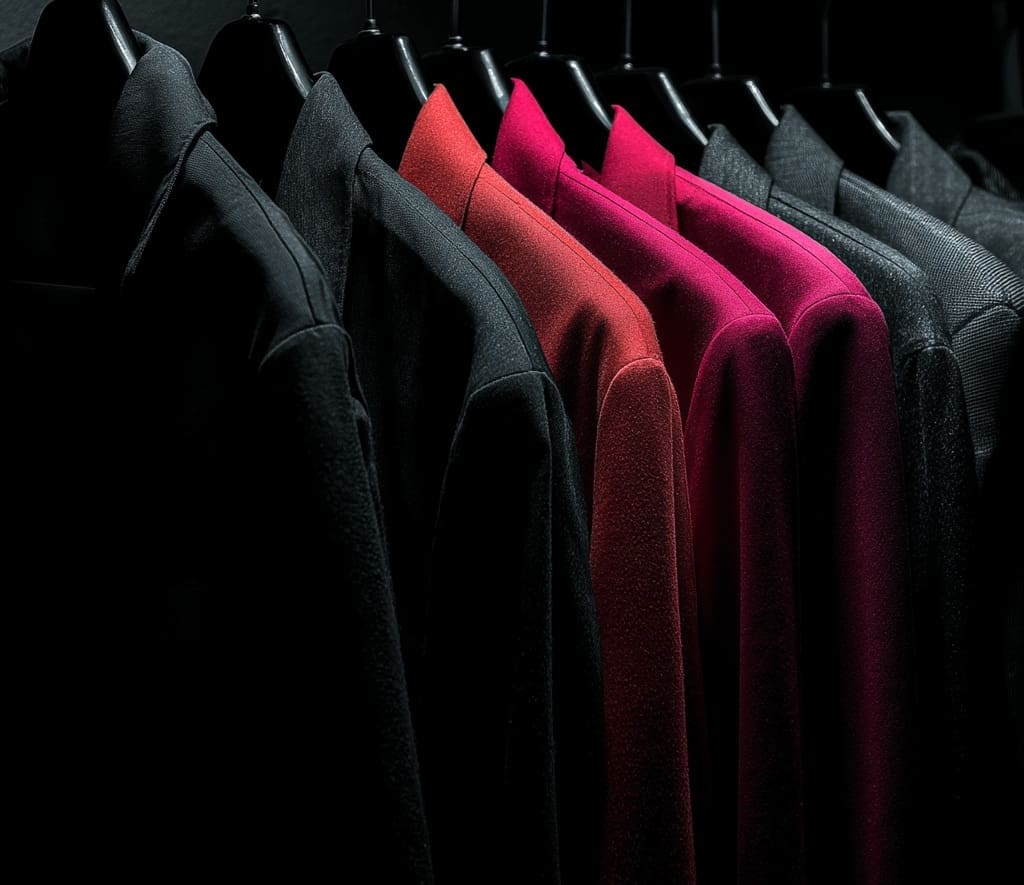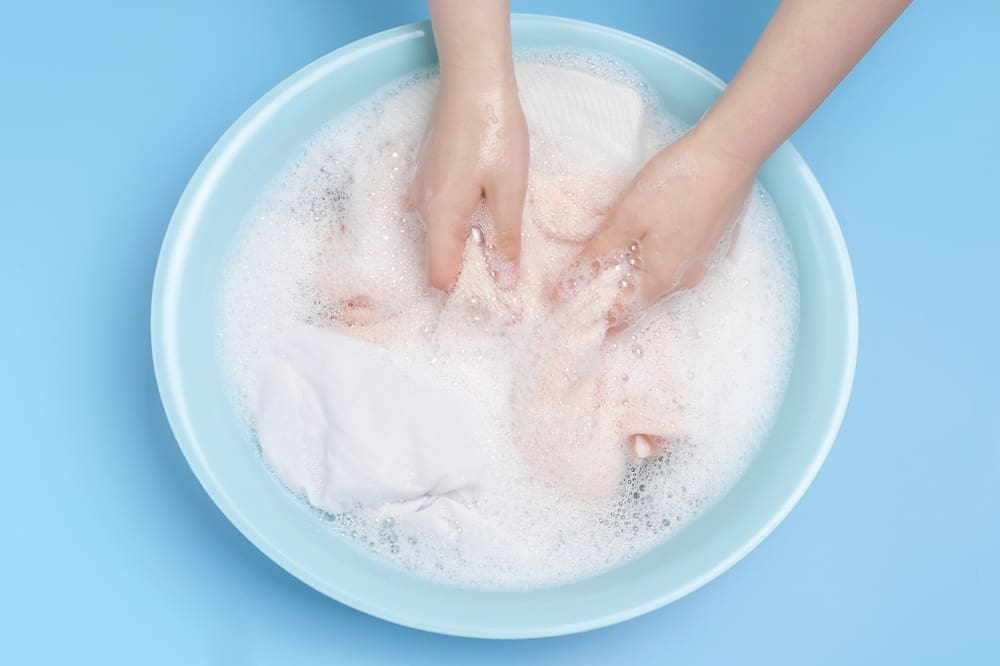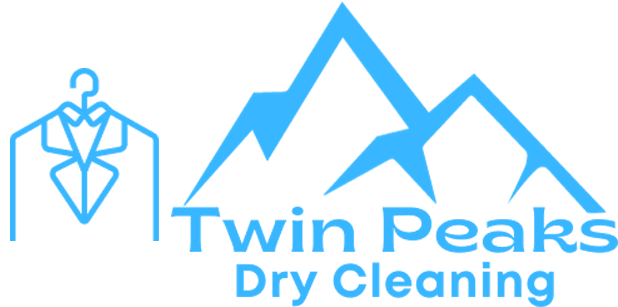We’re often really careful when washing whites. We separate loads, check temperatures, and skip the bleach if we’re unsure. But for some reason, dark clothes don’t get the same level of attention. Maybe because fading doesn’t happen in one big, obvious moment. It’s slow. Subtle. You don’t notice it until that rich black turns soft gray, or your favorite deep tones start looking a little tired around the edges. And by then, it’s usually too late.
If you’ve ever felt frustrated watching your favorite pieces lose color, give these tips a try. They are practical, doable, and totally worth it. Let’s get into them.
1) Wash in Cold Water Only to Prevent Color from Bleeding and Fading
The temperature of your wash water makes a big difference in caring for your dark garments. Using cold water helps lock in color, so your black dress shirts and deep navy pieces stay bold instead of turning faded and dull. Cold water also reduces fabric wear and saves energy, making it a smart choice for both your wallet and your wardrobe.
How Cold Washes Preserve Rich Color
- The cold water helps prevent dye transfer and fading because heat opens up the fibers, allowing the dye to escape.
- It also keeps delicate materials like silk, suede, or certain dark knits from shrinking or warping.
- Sticking to cold water every time builds a strong foundation to keep dark clothing rich and bold.
2) Use a Gentle, Color-safe Detergent Specifically Designed for Dark Clothing
The type of detergent you use can make or break your laundry results. Regular detergent might contain brighteners and harsh ingredients that strip color from your favorite dark pieces. A color-safe detergent is designed to clean without lifting away the dye, so you don’t lose that deep, bold hue over time.
What to Look for in a Detergent
- Choose a liquid detergent labeled for darks or colors because it dissolves easily and leaves less residue.
- Avoid anything with bleach or “optical brighteners,” which are meant to make whites pop but can seriously fade dark clothing.
- Brands like Tide have special formulas specifically for darks, and investing in them keeps your dress shirts and jackets looking newer for longer.
3) Turn Clothes Inside Out Before Washing to Reduce Surface Friction and Dye Loss
It might seem like a small step, but turning your clothes inside out is one of the easiest ways to protect color. When clothes rub against each other in the wash, the outer surface takes the most beating. By flipping garments inside out, you shield the side people see from direct friction and excessive contact with detergent.
Here’s how to do it right:
- Take a minute before tossing clothes into the hamper or machine. Make it a habit to grab each dark item and give it a quick flip. Do it while sorting, so you don’t forget before the wash starts.
- Pay attention to details. Zip zippers, unroll sleeves, and smooth out hems if needed. This keeps things from snagging or twisting mid-cycle, which also helps protect the fabric.
- Be consistent. Turn all your dark-colored pieces inside out every time you wash them: jeans, T-shirts, dresses, hoodies. It only takes a few extra seconds, but it really adds up over time.
- Still wash with care. Even inside out, darks should go in on a gentle or normal cycle with cold water (but more on that in another tip). You’re just giving them another layer of defense by reducing abrasion to the dyed surface.
4) Select a Gentle or Delicate Cycle on Your Washing Machine to Minimize Wear on Fibers
Your washing machine has a lot more power than you might think, and not always in a good way. The cycle you choose determines how roughly your clothes get tumbled around. A gentle or delicate cycle uses slower spin speeds and less agitation, which helps preserve both color and fabric integrity.
How to Choose the Right Wash Setting
- Go for "Gentle" or "Delicate" cycles. These settings use slower spin speeds and less agitation, exactly what dark fabrics need to avoid unnecessary wear.
- Avoid "Normal" or "Heavy Duty" cycles. These might sound like they clean better, but they’re rough on fabric and can cause color loss faster than you think.
- Check your machine's manual. Some washers have specific cycles labeled for “Dark Colors” or “Color Care” — use them if available.
- Shorter is better. Choose a shorter cycle when possible to reduce exposure to water and friction.
5) Avoid Using Bleach or Harsh Chemicals, Which Strip Away Dark Dyes Quickly
Bleach is great for brightening whites, but it’s a disaster for dark clothes. Harsh chemicals like chlorine bleach break down fabric fibers and literally strip color molecules from your clothing, leaving uneven spots or permanent light patches. Even many standard stain removers can be too aggressive on dark garments.
Safe Alternatives to Bleach
- Use a color-safe stain remover or diluted vinegar for spot cleaning.
- Always test products on a hidden area first to avoid blotchy or discolored spots.
- If you’re ever unsure, check with a local cleaning service or nearby clothes cleaners for expert advice.
6) Wash Dark Items Separately from Light and Bright Clothes to Prevent Color Transfer
Color transfer is one of the main reasons dark clothes lose their richness. When dark and light clothes are washed together, the dark dyes can bleed onto lighter items, and vice versa, causing muddy, dull colors all around. Even if your detergent says it “locks in color,” mixing loads is still a risky move.
How to sort items properly:
- Sort by tone, not just by color. Keep deep blacks, navies, and charcoals together. Mid-tones (like burgundy or olive) can go into their own group if needed. Avoid mixing them with whites, pastels, or anything neon.
- Don’t trust color-locking detergents alone. Sure, they help, but they’re not magic. Separation is still your best bet for protecting those saturated tones.
7) Don’t Overload the Washing Machine, So Clothes Have Space to Move Gently
It’s tempting to throw everything in at once to save time, but overloading your washer is a major mistake for dark clothing. When the drum is too full, clothes rub together excessively, causing extra friction that breaks down fibers and pulls dye out of the fabric.
How to Load Your Washer Correctly
- Aim to fill the drum about two-thirds full, leaving enough space for clothes to circulate freely.
- This gives each piece enough room for an even, gentle wash.
- Better circulation also means detergent rinses out more effectively, preventing residue that can make dark clothes look faded or dusty.
- Following this tip will noticeably extend the life and color of your entire dark wardrobe.
8) Air Dry in the Shade Instead of Using High Heat in the Dryer, Which Fades Dark Colors
Dryers might be convenient, but they’re notorious for sucking the life out of dark clothes. High heat speeds up fading and can even cause shrinkage or warping in delicate fabrics. Air drying in a shaded, well-ventilated spot is always the best option to preserve color.
The Right Way to Air Dry
- Hang clothes on a rack or lay them flat, away from direct sunlight.
- While sunshine can feel fresh, UV rays are harsh on dark fabrics and can bleach them quickly.
- If you must use a dryer, choose the lowest heat setting and remove clothes while they’re slightly damp to minimize damage.
- This simple switch can keep your black dress shirts and dark jeans looking sharp for far longer.
9) Treat Stains Gently with Mild, Color-safe Products, Avoiding Scrubbing That Can Cause Light Spots
Dealing with stains on dark clothing can be stressful. One wrong move and you could end up with a permanent faded patch. Many people instinctively scrub stains hard, but that friction causes localized fading. Instead, always blot stains gently with a damp cloth and use mild, color-safe products to lift the mark.
How to do it right:
- Gently dab (don’t rub) the stain with a clean, damp cloth to remove surface residue.
- Apply a small amount of a color-safe stain remover and let it sit according to product instructions.
- Wash the garment using cold water and a gentle cycle.
- Reach out to a local cleaning service or the nearest cleaners for clothes if you're unsure; many offer stain treatment as part of their customer service.
- Keeping their mobile app or email address handy makes it easier to ask for help and avoid turning a small stain into a bigger problem.
Protect the Bold Look You Love — Make the Switch to Twin Peaks Dry Cleaning!

With the right professional care, you can keep every dress shirt, dress, and jacket looking sharp, bold, and full of life. At Twin Peaks Dry Cleaning, we know what it takes to make heads turn: crisp collars, clean seams, and flawless cuffs that radiate confidence.
For over 18 years, we’ve helped Tucson’s professionals and entrepreneurs make strong, lasting impressions with expertly cleaned and perfectly pressed garments. Located in the Safeway plaza, we proudly serve Continental Ranch, Sunflower, and Saguaro Bloom neighborhoods, offering fast two-day service and on-site cleaning for total peace of mind, all at some of the best rates in town.
Give us a call at 520-332-6731 or swing by and experience for yourself the quality of our Dry Cleaning Service.
Slime is a great sensory play for children. But for parents, that same squishy, stretchy substance that keeps your child happily occupied for hours can quickly become your biggest laundry headache. The combination of glue, food coloring, glitter, and even shaving cream makes slime one of the most stubborn messes to tackle in laundry. And if you’ve ever tried to pick dried slime out of fabric with your fingers or scrub it out with hot water, you already know it’s not that simple.
But the good thing is, most slime messes can be cleaned, even if they’ve dried or been sitting overnight. The key is using the proper technique in the right order. So here’s how to break down the slime and get your child’s clothes back to normal.
Step 1: Gently Scrape Off the Excess
Before you reach for the cleaning supplies, your first priority is to remove as much of the slime as possible without spreading it further. Use a butter knife, a spoon, or even a dull-edged credit card to gently lift the bulk of the slime off the surface of the fabric.
- Do not rub or scrub at this stage, you’ll only work the slime deeper into the fibers.
- If the slime is extra sticky, place the item in a plastic bag and freeze it for 10–15 minutes. Once it’s hardened, it will peel off more easily.
This step is all about patience. The more you can remove now, the easier it’ll be to treat what’s left behind.
Step 2: Soak the Area in White Vinegar
White vinegar is an incredibly effective, natural solution for breaking down the sticky glue component found in most homemade slimes. It’s gentle on fabrics like cotton, polyester, and linen, and it won’t discolor most clothing if used properly.
- Lay the item flat over a clean towel or sink.
- Saturate the slime-affected area with white vinegar.
- Let it sit for about 5 to 10 minutes.
After soaking, use your fingers or a soft brush to gently work the vinegar into the fabric. This helps loosen the slime at a molecular level.
Step 3: Rinse with Cold Water
After treating the stain with vinegar, it’s time to rinse. Turn the fabric inside out or hold it under cold water from the back side of the stain. This pushes the broken-down slime out of the fibers rather than forcing it deeper in.
Why cold water? Hot water may seem like it would help, but it can actually cause slime’s glue and coloring to set, especially if glitter or dye is involved.
- Rinse thoroughly until the water runs clear.
- Gently squeeze out excess moisture, don’t wring or twist the fabric.
Step 4: Apply Liquid Dish Soap or Laundry Detergent

Now that the gluey parts are out, it’s time to tackle any remaining residue or discoloration. Apply a drop or two of liquid dish soap or a gentle laundry detergent directly onto the affected area.
- Rub in the soap with your fingers or use a soft-bristled brush.
- Let it sit for another 5 to 10 minutes.
Dish soap is especially good for lifting any oily ingredients (like lotion or shaving cream) that may have been part of the slime recipe. Detergent works well for breaking down lingering particles and prepping the garment for machine washing.
Step 5: Machine Wash on a Cold, Gentle Cycle
Once pretreated, wash the clothing on a cold, gentle cycle with a mild detergent. Cold water continues to prevent setting while also helping to rinse away any loosened particles from the treatment process.
- Do not add bleach or fabric softener.
- Avoid throwing multiple stained items into the same load this could lead to cross-contamination.
If your laundry setup includes a mesh garment bag, consider using it to protect delicate items or clothing with multiple layers, like hoodies or frilled dresses.
Step 6: Air Dry Flat (Don’t Use the Dryer Yet)
This is where many people go wrong, throwing the garment into the dryer before confirming the slime stain is completely gone. The heat from a dryer can permanently set the stain and make future removal nearly impossible.
- Lay the clothing flat on a clean, dry towel.
- Avoid hanging, which can cause stretching or distortion in some fabrics.
- Let it air dry completely, then re-inspect.
If you still see signs of the stain after drying, repeat the process from the vinegar soak before washing again.
Save That Slime Stained Shirt with a Visit to Twin Peaks Dry Cleaning. Call Us Today for All Your Dry Cleaning Needs!
Tried everything and still stuck on that slimy thing on your clothes? Don’t stress, Twin Peaks Dry Cleaning offers reliable, on-site cleaning and pressing, providing meticulous care for all garments. Our expert stain removal process targets even the toughest messes, yes, even glittery, gluey slime, without damaging delicate fabrics. Because every step happens right here in our store, we keep full control over quality, turnaround time, and competitive pricing.
For over 18 years, we’ve been Tucson’s trusted name in dry cleaning, proudly serving the Continental Ranch, Sunflower, and Saguaro Bloom neighborhoods.
Have questions or want to schedule a service? Drop in and see us!
Our location:
📍 9110 N. Silverbell Rd., Suite 160 Tucson, AZ 58743
You can also call at 520-744-9310 or send us an email at twinpeaksdrycleaners@gmail.com.
🕒 Open Monday & Friday: 8:00 AM – 6:00 PM | Tuesday - Thursday: 8:00 AM – 5:00 PM | Saturday 9:00 AM – 3:00 PM
No matter how careful you are, there will always be days when food ends up somewhere it shouldn’t—like your shirt, your lap, or the sleeve of your favorite blazer. Although some food stains can be lifted easily, others—like wine, oil, or tomato-based sauces—can turn into stubborn problems if not handled the right way.
And so, how you handle it in the moment and afterward will either save your clothing—or make the stain worse. This article lays out the eight biggest mistakes people make when dealing with food stains and what you can do to avoid setting them in for good.
Mistake #1 — Letting the Stain Sit Too Long Before Treating It
When a stain sits too long, it begins to bond with the fabric fibers, making it much harder to remove later—especially if it dries completely. Foods like tomato sauce, chocolate, and coffee can quickly soak into the fabric, becoming nearly permanent if not addressed in time.
What to Do Instead: Act Quickly, Even If It’s Temporary
Even if you can’t treat the stain immediately, take 30 seconds to blot it and rinse it with cold water. You can also gently dab with a mild stain remover (one that’s safe for your fabric type) to stop it from setting. Acting fast gives your dry cleaner a better chance of removing it fully.
Mistake #2 — Scrubbing the Stain Aggressively
When food hits your clothes, your first instinct might be to scrub it like you’re scrubbing a dirty plate. But aggressive scrubbing can do more harm than good. It pushes the stain deeper into the fabric fibers, spreads it outward, and can permanently distort the weave or texture of the material. For delicate fabrics like silk, satin, or lightweight cotton, even mild friction can lead to pilling, fraying, or discoloration.
What to Do Instead: Blot Gently
Instead of scrubbing, blot the area with a clean white cloth or paper towel. Gently press down to lift the stain without spreading it. Always blot from the outside in to keep the stain from widening. This buys you time until you can properly treat the area—or take it to a professional dry cleaner.
Mistake #3 — Using Hot Water on the Wrong Stain or Fabric
Hot water is not suitable for every situation. While it can help with oily stains on durable fabrics, it can also permanently set protein-based stains (such as milk, eggs, or meat juices). It may also shrink or distort fabrics like wool or cashmere.
How to play it safe:
- Start with cold water if you’re unsure about the fabric or the type of stain.
- Use warm water for greasy stains on sturdy fabrics like cotton only after checking the care label.
- Always verify the clothing label instructions before applying heat in any form.
Mistake #4 — Ignoring the Fabric Type
Different fabrics react differently to cleaning methods. A process that works well for a cotton T-shirt may ruin a wool sweater, stretch out a linen dress, or damage a leather jacket. Using the wrong method can lead to permanent discoloration, fabric warping, or even holes.
Here’s what to consider:
- Carefully read the garment’s care label before applying any stain treatment.
- Know the basics:
- Linen may wrinkle or shrink if exposed to high heat or harsh scrubbing.
- Sweaters (especially wool or cashmere) should be handled with care and may require hand washing or dry cleaning.
- Leather and suede are sensitive to moisture and should be handled by a specialist.
When in doubt, take the garment to a professional clothes cleaner who specializes in fabric care.
Mistake #5 — Skipping a Spot Test on Delicates or Formalwear
Applying a cleaning product directly to delicate or expensive clothing—like formalwear, environmentally friendly fabrics, or a silk blouse—without testing it first can lead to damage. Some products may bleach the fabric, stiffen it, or cause discoloration.
Here’s how to do a spot test:
- Choose a small, hidden section of the garment (such as the inside of a hem or seam) to apply a spot test.
- Wait a few minutes to see if the fabric changes color, stiffens, or reacts poorly.
- Only continue with the product if no visible changes occur.
Mistake #6 — Overloading the Washing Machine with Stained Items
Filling your washing machine to the top may seem efficient, but it can reduce the effectiveness of stain removal. When clothes are packed too tightly, they can’t move freely, and the water and detergent can’t reach every spot.
What to do instead:
- Wash stained garments in smaller loads to allow proper water and detergent circulation.
- Pretreat stains before placing the clothing into the machine.
- Separate items by fabric type and color, especially if you’re washing delicate clothing like linen, formalwear, or wool sweaters.
Mistake #7 — Using the Wrong Cleaning Product for the Stain Type
Not all cleaning products work for every stain. Using the wrong one can set the stain permanently or damage the fabric. For instance, using bleach on a tannin-based stain like wine or coffee can make it worse or cause yellowing on white clothing.
Match the product to the stain:
- Grease or oil (e.g., butter, dressing): Use a degreaser or dish soap.
- Protein-based stains (e.g., dairy, meat, egg): Use an enzyme-based cleaner.
- Tannin stains (e.g., wine, tea, coffee): Use cold water first, then a tannin-specific product.
If you’re unsure which cleaning product to use, consult your nearest professional clothes cleaner—they can recommend the best option or handle the cleaning for you.
Mistake #8 — Tossing Stained Clothes Into the Dryer Before Checking Them
Heat from the dryer can set a stain permanently. Even if a stain appears to be gone after washing, it may still be faintly visible—and once it’s been heated, removing it becomes significantly harder, if not impossible.
Here’s what you should do instead:
- Before drying, inspect the garment under good lighting to see if the stain is completely gone.
- If any trace of the stain remains, repeat the cleaning process or consult a professional cleaner.
- Air dry the item if you're unsure. This gives you another chance to treat the stain without the risk of setting it in with heat.
Get Professional Help Before That Stain Becomes Permanent — Call Twin Peaks Dry Cleaners Today!

Whether it’s a splash of red wine, a coffee spill during your commute, or a greasy takeout mishap, stains don’t wait—and neither should you. The longer they sit, the harder they are to remove. That’s why it's important to get expert care before that spot becomes a permanent part of your favorite dress shirt, jacket, or formal suit.
For over 18 years, Twin Peaks Dry Cleaners has been Tucson’s trusted name in garment care, proudly serving the Continental Ranch, Sunflower, and Saguaro Bloom neighborhoods. We handle all cleaning and pressing on site, so your clothes never leave our care—no outsourcing, no third parties, just reliable service and quality you can see.
We offer competitive pricing, fast turnarounds, and the kind of attention to detail that’s earned us the loyalty of our local community.
You are always welcome to drop by our store in the Safeway Plaza next to Subway if you have a specific question on a specific stain. Calling is an option at 520-744-9310 but we can’t see your stain over the phone. Same for email at twinpeaksdrycleaners@gmail.com.
